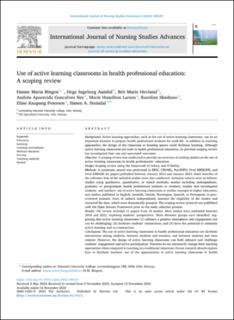| dc.description.abstract | Background: Active learning approaches, such as the use of active learning classrooms, can be an important measure to prepare health professional students for work-life. In addition to teaching approaches, the design of the classroom or learning spaces could facilitate learning. Although active learning classrooms are used in health professional education, no previous scoping review has investigated their use and associated outcomes.
Objective: A scoping review was conducted to provide an overview of existing studies on the use of active learning classrooms in health professionals’ education.
Design: Scoping review using the framework of Arksey and O’Malley.
Methods: A systematic search was performed in ERIC, CINAHL, PsycINFO, Ovid MEDLINE, and Ovid EMBASE for papers published between January 2012 and January 2023. Hand searches of the reference lists of the included studies were also conducted. Inclusion criteria were as follows: studies using qualitative, quantitative, or mixed methods; studies including undergraduate, graduate, or postgraduate health professional students or teachers; studies that investigated students’ and teachers’ use of active learning classrooms or similar concepts in higher education; and studies published in English, Swedish, Danish, Norwegian, Spanish, or Portuguese in peer reviewed journals. Pairs of authors independently assessed the eligibility of the studies and extracted the data, which were thematically grouped. The scoping review protocol was published with the Open Science Framework prior to the study selection process.
Results: The review included 11 papers from 10 studies. Most studies were published between 2018 and 2022, exploring students’ perspectives. Three thematic groups were identified, suggesting that active learning classrooms (1) enhance a positive atmosphere and engagement but can be challenging; (2) facilitate students’ interactions; and (3) have the potential to stimulate active learning and co-construction.
Conclusions: The use of active learning classrooms in health professional education can facilitate interactions among students, between students and teachers, and between students and class content. However, the design of active learning classrooms can both enhance and challenge students’ engagement and active participation. Teachers do not necessarily change their teaching approaches when compared to teaching in a traditional classroom. Future research should explore how to facilitate teachers’ use of the opportunities in active learning classrooms in health professional education and students’ learning outcomes, as well as the effect of high-technology active learning classrooms versus low-technology active learning classrooms on the intended learning outcome.
Tweetable abstract: The use of active learning classrooms can facilitate active learning, but teachers do not necessarily change their teaching methods. | en_US |

